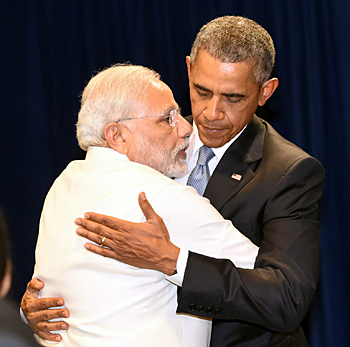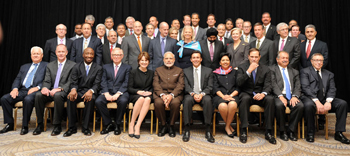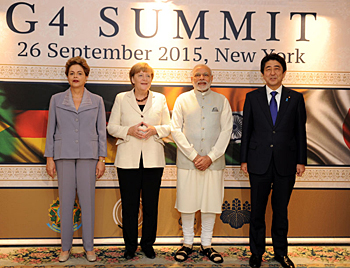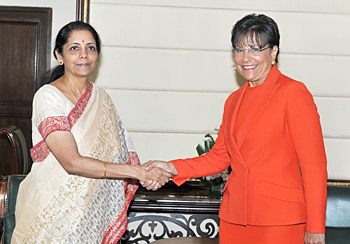INDIAN ARMED FORCES CHIEFS ON
OUR RELENTLESS AND FOCUSED PUBLISHING EFFORTS

SP Guide Publications puts forth a well compiled articulation of issues, pursuits and accomplishments of the Indian Army, over the years

I am confident that SP Guide Publications would continue to inform, inspire and influence.

My compliments to SP Guide Publications for informative and credible reportage on contemporary aerospace issues over the past six decades.
- Prime Minister witnesses 'Bharat Shakti' – a Tri-Services Firing and Manoeuvre Exercise in Pokhran, Rajasthan
- Interim Defence Budget 2024-25 — An Analysis
- Union Defence budget 2024
- Indian Army: In quest of greater firepower and policy recommendations for gaps
- Indian Army Annual Press Conference 2024
- 6G will transform military-industrial applications
Giving economic muscle to strategic partnership - Modi in USA
India and US have already achieved a bilateral trade of US $ 100 billion and aim to raise this to the level of US$ one trillion by 2030.




Before the fifth bilateral interaction between Barack Obama and Narendra Modi on 28th September , the two foreign ministers John Kerry and Sushma Swaraj had only a week ago laid the ground work for their talks under the aegis of the first ever combined strategic and commercial dialogue. That US and India strategic relations are on a new trajectory need not be reiterated, the changing geopolitics of the Asia-Pacific region is encouraging the two democratic powers to come closer. Economic and Defence trade forms the bulwark of this relationship and has seen an exponential rise since the middle of the last decade. A decade ago defence trade between India and USA was almost negligible, but consistent efforts by the US leaders and officials, by relaxing its national defence export laws, led to a burgeoning of defence trade relations, which has now become a subject of envy for other countries having strong defence exchanges with India. The two countries now plan to give a new dimension to their strategic partnership on global issues.
The two countries have now expanded the strategic dialogue to encompass commercial ties also, as trade and economic relationships will develop a strong stake in the prosperity and stability of both the countries. With this aim, for the first time, the two countries exchanged frank views on strengthening economic ties. To give effect to this commitment between the two countries, the US Commerce Secretary Penny Pritzker and Indian commerce minister Nirmala Sitharaman along with their teams participated in talks with full strength. During Modi's visit to UN Headquarters, India was the talk of the town especially among business and strategic circles. Local media quoted a Technology entrepreneur and academic, Vivek Wadhwa as saying," Usually CEO's don't spare time for even Heads of States, and they keep a safe distance from Washington DC. In fact Modi was the first Head of State to visit the headquarters of Facebook campus in Menlo Park."
To enable India to play its new global role, the US is encouraging India to strengthen its defence capabilities and helping India acquire latest weapon systems and platforms. The US side has also agreed to support India for early membership of the Asia Pacific Economic Community, which will enhance India's profile in the region. India and US have already achieved a bilateral trade of US $ 100 billion and aim to raise this to the level of US$ one trillion by 2030. Considering the strength and possibilities of the two countries, this can be achieved, the rest of the world realize this. Hence India is being courted by all the powers from West to East.
An official US document acknowledges with pride that US has signed more than US$ 10billion in defence trade with India , which has strengthened India's capacity as a net provider of security in the Indian Ocean region. The inking of latest US$3.1 billon deal for Apache and Chinook helicopters has added another feather in its cap. Thus the total deal during last one decade will now be US$ 13 billion. Giving the example , the US document says that Indian Air Force used US made C-130 and C-17 aircraft to evacuate Indian and third country nationals from Yemen and speed relief supplies to Nepal after it's devastating earthquake in Nepal. The India US defence supply relations are now turning a new leaf and from buyer seller relationship both are entering a new era of joint developer of weapon systems and platforms , under the aegis of the Defence Trade and Technology Initiative(DTTI).
Prime Minister Modi acknowledged before President Obama during his meeting on 28th September in New York , "Our partnership addresses a broad range of strategic and security concerns. Our defence cooperation, including defence trade and training, is expanding." India is keen to enhance its maritime security and has adopted a policy to draft the likeminded countries for exchange of ideas and programme. Prime Minister Modi made a strong pitch for obtaining a chair on the High Table of the world and US , Britain, Russia and France did not dither from declaring their support for the permanent membership of the United Nations Security Council. Modi successfully hosted a summit of the G-4 group (India, Germany, Japan and Brazil), though they have off-late become a reluctant campaigner for the UNSC seat.
The visit of Prime Minister Modi led to reaffirmation of the aims of India-US strategic partnership as they recognized it to be a significant contributor to the peace, stability and prosperity in the Indian Ocean and Asia—Pacific regions and around the globe. Since China aims to emerge as a major player and claimant of the space in these areas , the joint commitment by the world's only super power USA and India , the emerging power, to jointly take care of their strategic and economic interests is extremely significant. President Obama and Prime Minister Modi also reasserted their continued cooperation under the joint strategic vision for the Asia-Pacific and Indian Ocean region. Considering the continued forays of the Chinese warships in the Indian Ocean region, the two powers visualize Chinese aggressive efforts to dominate the sea to protect its energy supply routes and trade with Africa, which the Chinese now plan to connect via Gwadar port of Pakistan through the Kashgar region of Xinjiang. A 1,500 kms long China-Pakistan economic corridor is under execution, on which Chinese government plan to invest around US$ 46 billion.
The Chinese want a direct sea route connection through land route of Pakistan. Hence the strategic guardians of India and US are wary of increased Chinese maritime activity in the region. USA-India strategic partnership assumes significance from this perspective. Along with the two countries, Japan has also been added and a kind of triangle is emerging in the Asia—Pacific region. Significantly foreign ministers of these three countries met in New York for the first time in this format and issued a veiled warning to China to desist from solving the sea disputes in the two China seas through force. China has recently constructed an artificial air strip on the disputed region and is trying to grab the maritime area.
The India US strategic relationship thus has ramifications in the Asia-Pacific region. And in this context, US would like India to emerge as a counter balance to China, for which India's emergence as an economic power is a necessary pre-requisite. The US side facilitated this during Modi's visit to New York and California, where he interacted with the top CEO's of US and the world. The world is looking towards India as an emerging economic power, whose stability and progress is now vital for their well-being.
In New York and in Silicon Valley, Prime Minister Modi reached out to the business leaders and reassured them that India is indeed the place today to invest in. Modi was able to convey to the world business leaders that India can no longer be ignored. Modi's photo-ops with the chosen 42 Fortune 500 CEO's was a landmark event for any Head of State visiting USA. In today's world a country commands respect only when it has economic backing. And India under Modi has been able to project itself as an economic magnet of the world. Economic strength will also add muscle to India's strategic strength and profile.





